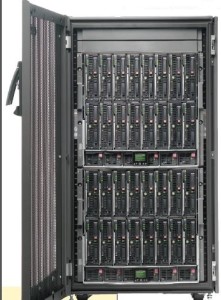Tags
Related Posts
Share This
Parallel RIP Fires Digital Web Press
by Henry Freedman

With 16 dual processors,HP Blade servers supply the data power needed for the Océ JetStream 2200 twin system.
We are on the doorstep of the elusive higher speed and higher quality digital web press. The next five years will see the turning point. Finally, barriers are falling, leading to increasingly higher speed digital color web presses, which I define as a paper web with process color at speeds of 800 perfected 8.5×11″ pages a minute or faster. Océ has now set the speed record for a commercial quality variable imaging digital color web press, the JetStream 2200, at a whopping 2,180 pleasing color 600×600- dpi pages per minute.
What does it takes to deliver such a printing accomplishment? Océ fulfills its JetStream’s voracious appetite for imaging color at 37 pages per second, 500 fpm. It prints a 20.3″ image area on a 20.5″ web on a variety of substrates. Because it can image paper variably at all points, from page to page, or areas within each page, new capabilities occur that a conventional web press cannot perform. Also, JetStream does not have the limits of a fixed cutoff size, for example, since no plates are used or specific cylinder diameters or cylinder gaps exist. In essence, it can print images 20.3″ wide by any length.
Digital web presses can dynamically tile or stitch jetted image segments to the paper surface without limitation of cutoff size (other than the length of the roll itself). This is a big deal! No longer does a web press have the limit of fixed cutoff. Thus, color jobs of different cutoff lengths on the same paper type can be ganged one after the other during a run. No cylinder adjustments are required; just run the next job online/inline. Other digital webs can do this, but not as fast.
So how does all that data get on press at gigahertz speed to be jetted onto paper? Océ has developed (over 15 years of proven evolution) an ultra-fast RIP that is scalable as to how many computers it has. The manufacturer Raster Architecture. Presently, the JetStream press employees 16 dual-processor HP blade computers run in parallel, thus 32 microprocessors. Océ does not buffer data at the print head, so these computers process many gigahertz of data in real-time out to control the press imaging. For some, this may sound a little like Greek, however, it is important to define the new world of ink flow fired to paper.
Ink flow goes digital
The data rate the JetStream SRA system is designed to transfer is more than two gigabytes per second between the 16 parallel RIPs and the imaging head hardware. Each sheet generated out of the blades is uncompressed and transferred that way as either four planes (one bit), eight planes (two bit) at 150 megapixels a minute. As each page is fully variable, the complete plane is transferred for each page.
The data rate is accommodated by having eight Infiniband channels between the RIP and the imaging hardware. The controller processes 16 sheets (fronts and backs) in parallel and buffers about 500 pages (approximately, since it varies by page height) between the input and the imaging hardware. The calculation for data rate is 600×600 x pels width / 8 * pels height * 4 (1 bit) or * 8 (2 bit). This can translate into 60,000 scanned lines of ink record-to-paper per second. It is the new way now for our industry to define ink flow. And there are no fountains to clean.





